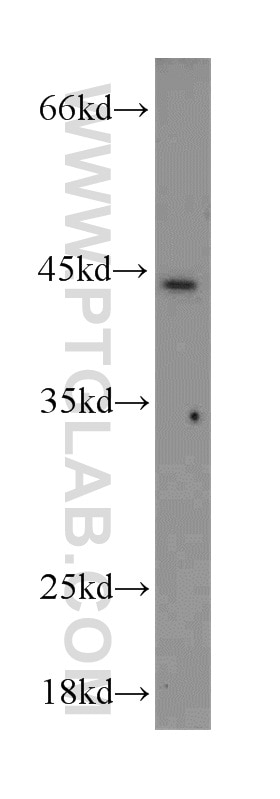Validation Data Gallery
Tested Applications
| Positive WB detected in | mouse liver tissue |
Recommended dilution
| Application | Dilution |
|---|---|
| Western Blot (WB) | WB : 1:200-1:1000 |
| It is recommended that this reagent should be titrated in each testing system to obtain optimal results. | |
| Sample-dependent, Check data in validation data gallery. | |
Published Applications
| WB | See 1 publications below |
Product Information
18732-1-AP targets HOXB1 in WB, ELISA applications and shows reactivity with human, mouse samples.
| Tested Reactivity | human, mouse |
| Cited Reactivity | human |
| Host / Isotype | Rabbit / IgG |
| Class | Polyclonal |
| Type | Antibody |
| Immunogen |
Peptide 相同性解析による交差性が予測される生物種 |
| Full Name | homeobox B1 |
| Calculated molecular weight | 32 kDa |
| Observed molecular weight | 38-44 kDa |
| GenBank accession number | BC096193 |
| Gene Symbol | HOXB1 |
| Gene ID (NCBI) | 3211 |
| RRID | AB_10597249 |
| Conjugate | Unconjugated |
| Form | |
| Form | Liquid |
| Purification Method | Antigen affinity purification |
| UNIPROT ID | P14653 |
| Storage Buffer | PBS with 0.02% sodium azide and 50% glycerol{{ptg:BufferTemp}}7.3 |
| Storage Conditions | Store at -20°C. Stable for one year after shipment. Aliquoting is unnecessary for -20oC storage. |
Background Information
HOXB1, also named as HOX2I, belongs to the Antp homeobox family and the Labial subfamily. HOXB1 is sequence-specific transcription factor which is part of a developmental regulatory system that provides cells with specific positional identities on the anterior-posterior axis. HOXB1 acts on the anterior body structures. Establishment of the spatial colinearity in the embryo is directly controlled by the Hox genes themselves. 18732-1-AP is a rabbit polyclonal antibody raised against a peptide mapping within an internal region of human.
Protocols
| Product Specific Protocols | |
|---|---|
| WB protocol for HOXB1 antibody 18732-1-AP | Download protocol |
| Standard Protocols | |
|---|---|
| Click here to view our Standard Protocols |

